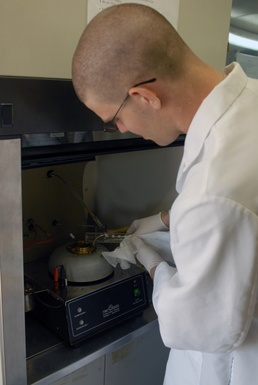
CAMP BONDSTEEL, Kosovo – All of the electricity on Camp Bondsteel is produced by diesel generators, which can use thousands of gallons of diesel fuel daily. In addition, all of the vehicles on base, including Multinational Battle Group East’s UH-60 Black Hawk helicopters, also need diesel fuel, gasoline or Jet Propellant 8 to run.
Before the fuel can be used on base, it must first go through quality control tests and be distributed to the various fuel points. All of the testing and much of the distribution is done by the petroleum supply specialists with Headquarters & Headquarters Company, 1-114th Security & Support Aviation Battalion, from Little Rock, Ark.
The fuel is transported in U.S. Army Heavy Expanded Mobility Tactical Trucks, which can carry more than 2,200 gallons of fuel. A one-gallon sample is taken from each HEMTT’s fuel load and run through a series of tests, including a fuel system icing inhibitor test to check the fuel’s freezing point, an electricity conductivity test, water and sediment tests and numerous other inspections. All of this fuel testing is handled by only three soldiers.
“In a normal week, I have to run tests for approximately 72 thousand gallons of fuel,” said Spc. Brandon Cressler of Fonda, Iowa, a petroleum lab specialist attached to the 1-114th. “In the winter, when the generators are using more fuel, those numbers can more than double.”
This testing is vitally important, said Spc. Herminio Damiani of San Juan, Puerto Rico, a petroleum lab specialist attached to the 1-114th. The tests are a quality control and determine if the fuel meets the standards required for it to be used on base, he added.
“For instance,” said Damiani, “one of the tests we run determines the sediment levels in the fuel. If there’s too much sediment, the truck that that fuel came from has to be shut down. All the filters have to be changed and all of the fuel must be circulated and tested again before we can use that truck’s fuel on base.”
As if testing all of that fuel doesn’t seem like enough work, the petroleum supply specialists with the 1-114th are also responsible for performing “hot refuels” on all of the battle group’s UH-60 Blackhawk helicopters.
During a “hot refuel”, a helicopter lands at a designated fueling point and remains running. Fuel is pumped from a nearby HEMTT by two petroleum supply specialists, while the crew chiefs from the helicopter standby with fire extinguishers in case of a fire. Once the fuel is pumped, the crew chiefs reload the helicopter and they take off again.
“Hot refuels work pretty well for us,” said Staff Sgt. Scott Poindexter of Madrid, Iowa, section chief for the petroleum supply specialists attached to the 1/114th. “We can get an aircraft refueled with approximately 350 gallons of fuel and get it back in the air in a matter of minutes.”
The “hot refuels” provide an asset to the aviation element through their sheer expedience, Poindexter said. Once the aircraft touches down for a hot refuel, the entire refueling process takes between five and 10 minutes. With a cold refuel, a HEMTT has to drive out to the aircraft, refuel it and drive back. This takes considerably longer, depending on the distance and terrain that must be traversed.
“As far as the overall aviation mission goes, I think we’re one of the most important aspects,” said Poindexter. “Without the speed and efficiency of military refueling assets, they (the helicopters and their pilots) are dead in the water, so to speak.”
Lt. Col. Timothy T. Taylor of Beebe, Ark., commander of Task Force Griffin, MNBG E’s aviation component, also spoke of the petroleum supply specialists’ importance to the aviation mission and offered some acclaim for some of his Soldiers that, he said, may not get enough sometimes.
“It’s a thankless job, or at least I’m sure the guys doing it think it is, but we absolutely couldn’t do our mission without the Soldiers that do our refueling,” Taylor said. “We (aviation) are the fastest responding, most maneuverable and possibly the most skilled asset available to this battle group. We offer them the freedom of maneuverability, regardless of terrain.”
The petroleum supply specialists are an integral part of providing that freedom to the battle group and they complete their duties regardless of the challenges they are often faced with, Taylor said.
“They don’t get enough credit,” Taylor added. “Those are the guys that are out there under the blades when it’s 2 degrees outside and all that wind is whipping in their face. That’s the most dangerous mission we do and they just go out there and do what needs to be done.”
“I’ve heard it said that without fuel, pilots are just pedestrians,” said Poindexter. “That pretty much sums up how important we are to the aviation mission.”